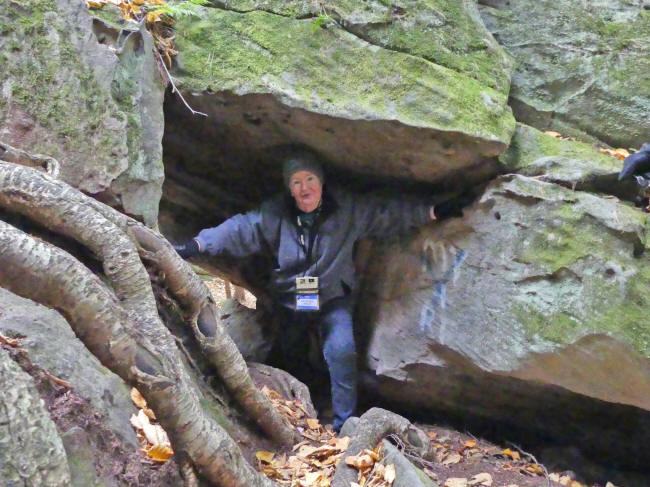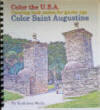Bilger’s Rocks:
A 300-Million-Year-Old
Rock City
Kathleen Walls
Published 11-1-2023
Bilger’s Rocks have been there since
before the
America continents split from Africa. It’s about 300-million
years old, give or take a few birthdays. Paleo-Indians used
some of its caves for shelter. The first European settler was a
German named Jacob Bilger in the 1800s. Today, it’s a park with
not only the rocks but a primitive camping area and playground
and the ruins of an old mill on Bilger’s Creek which runs
through the park. There are hiking trails and beautiful woods.

We did a small group tour at this year’s
MATPRA’s (Mid Atlantic Tourism Public Relations Alliance)
Welcome Tour. Unlike the better-known Rock City atop Lookout
Mountain, this one is not fancied up. It’s natural. Although
there are places where man has left a mark. Our guide pointed
out some carved graffiti, including one from 1921 featuring a
globe and the words, “The World is Looking to Us,” referring to
America’s place in world politics just after WWI. It was done
by John Lawson, a Swedish immigrant who had migrated to
Clearfield County and worked as a miner. He was an amateur
artist with no formal training. Another more elaborate carving,
probably much older, was a life-sized stone carving of a
crouching lion. The lion has lost some of its features, but you
can still see enough to tell what it is.
The walking path is more of a suggestion. It leads down into the heart of the rock formations and from there, it is not so evident. We wandered off into several crevices where someone much skinner than I am might have fit through. As some points in these passages, I could look up and see the friends in the group who chose not to climb among the rocks.
There is one large area called “Devil’s
Dining Room.” There’s a long tight crevice from this room leads
to the “Devil’s Dungeon” and the “Devil’s Kitchen.” A tight
passage near the end of the path leads to a room called “Ice
Cave” since in winter this spot keeps water frozen longer than
any other places around it. The formations are a labyrinth of
fun passages.

Legend suggests the frequent use of
“Devil” in the formation names refers to the early farmer’s
name for barren rock land that could not be farmed. Although
crops would not grow here, the trees have created some strange
sights. Roots led down along the sides of the cliffs from some
of the trees above. Human touches are seen on some of the
trees. One is carved with a humanoid face and a smaller sun
image on it.
Even for those who do not explore the
rocks themselves, there are amazing ground views down into the
crevices. Do use caution with small children or dogs, as they
could easily fall into these crevices. It’s a steep drop.
One of the newest features of the park is
“Rock House.” county-native Roland Welker won the History
Channel’s Season 7 television show, Alone by surviving
100 days in Canada’s arctic wilderness. “Rock House” is a
replica of the rock shelter he built to live in for those
frigid 100 days.
Bilger’s Rocks is in Clearfield County,
Pennsylvania, five miles north of Grampian. Do wear sturdy
walking shoes and be aware the path can get somewhat rugged.
There were places where I had to almost crawl to get up a
section of the path. This is a true natural treasure not to be
missed.































